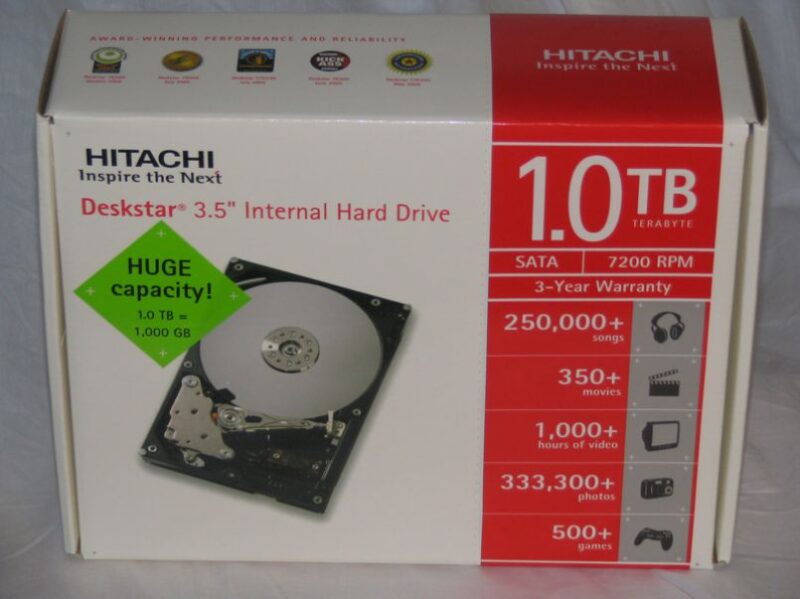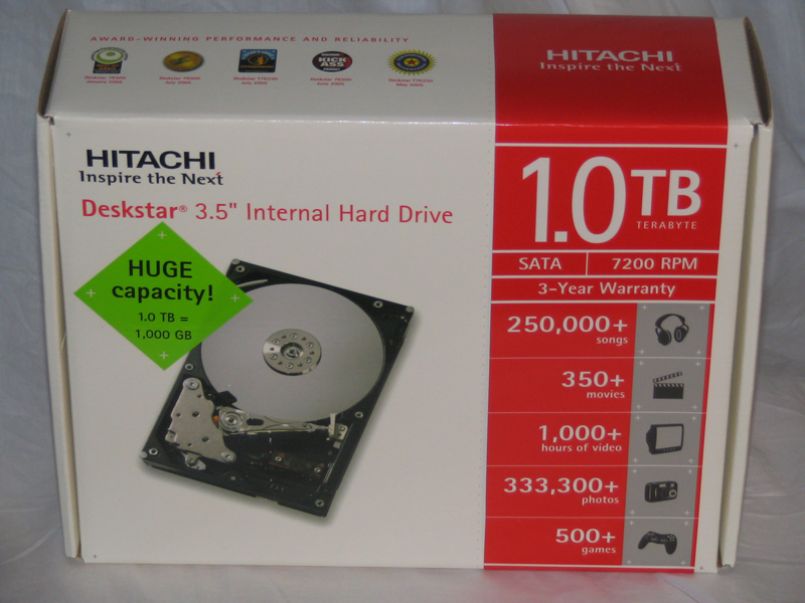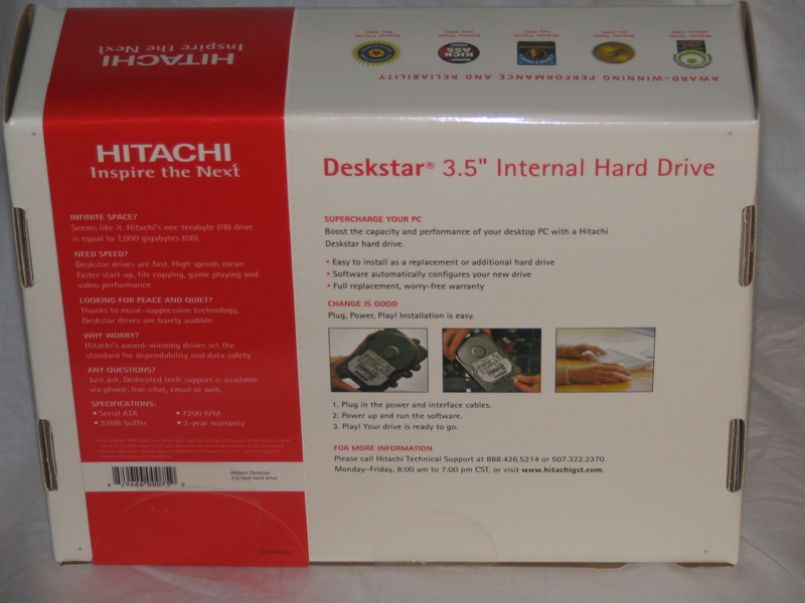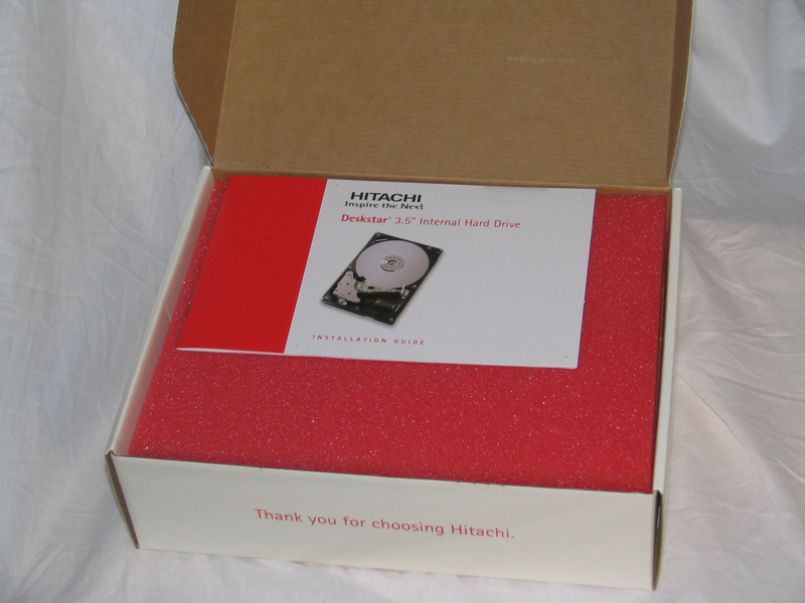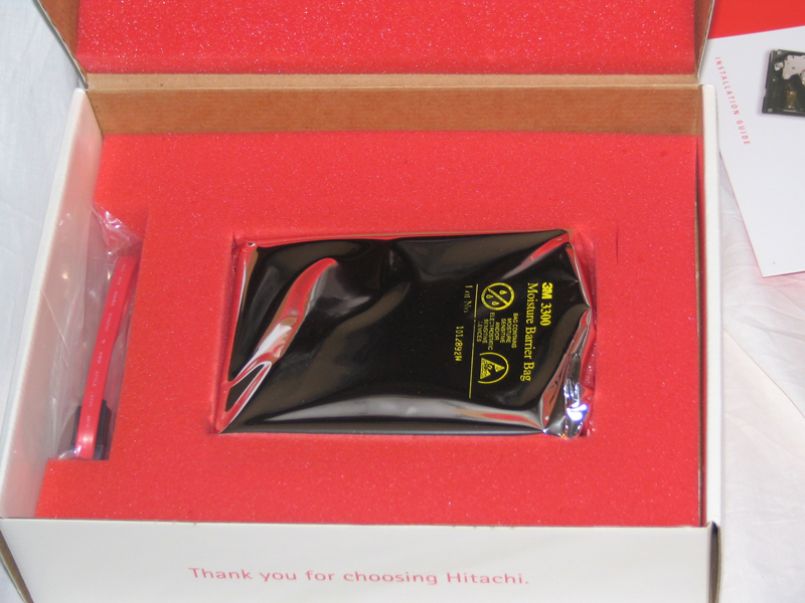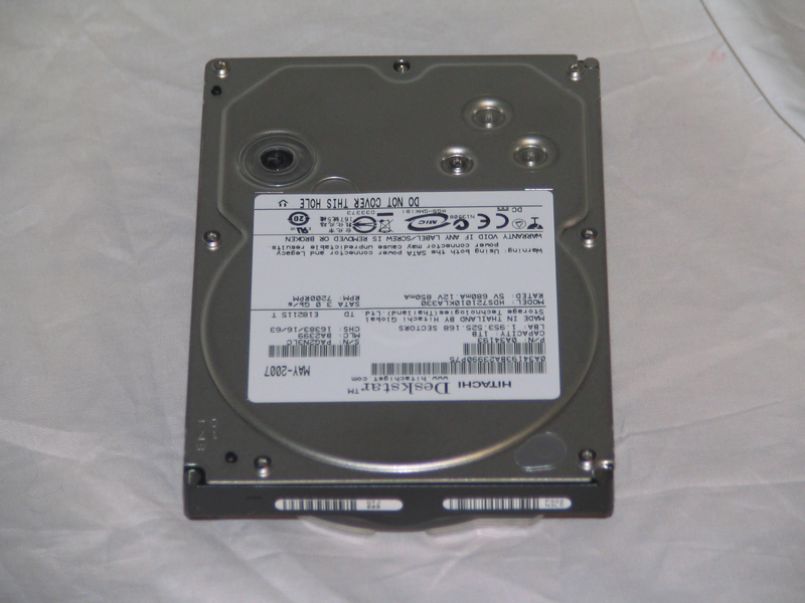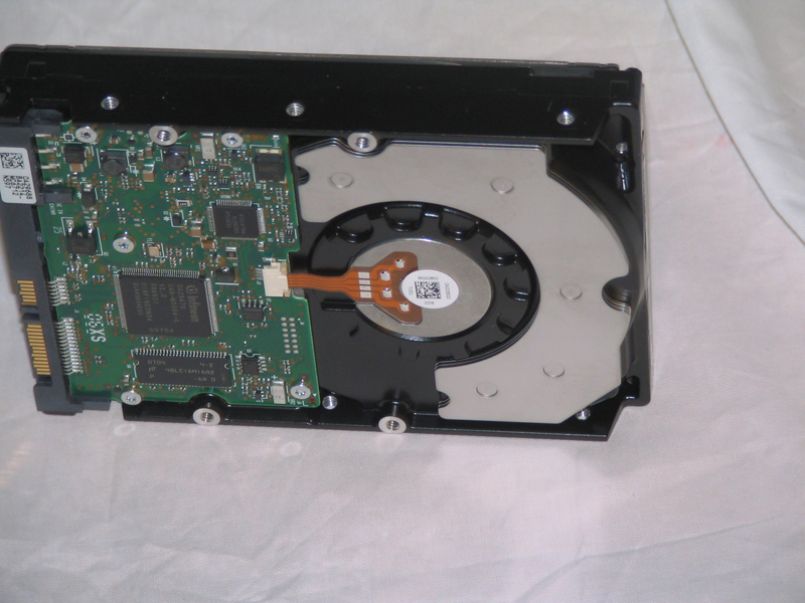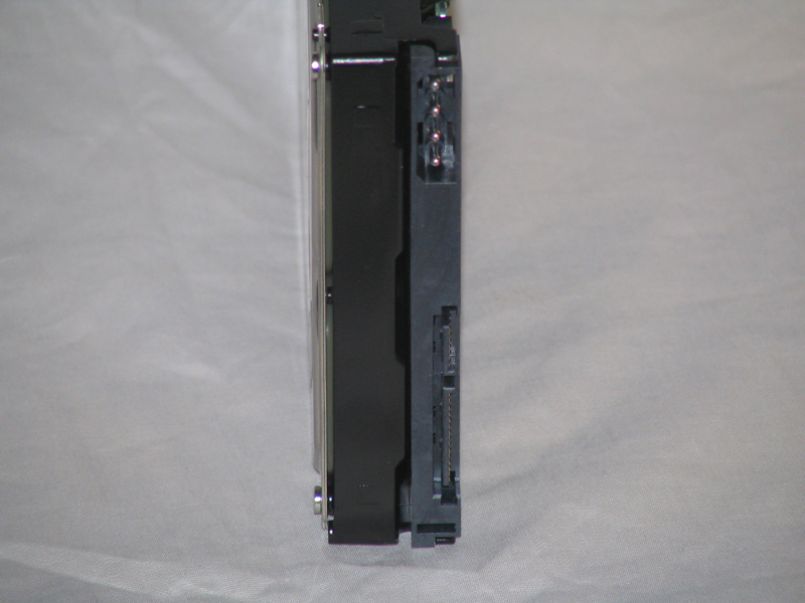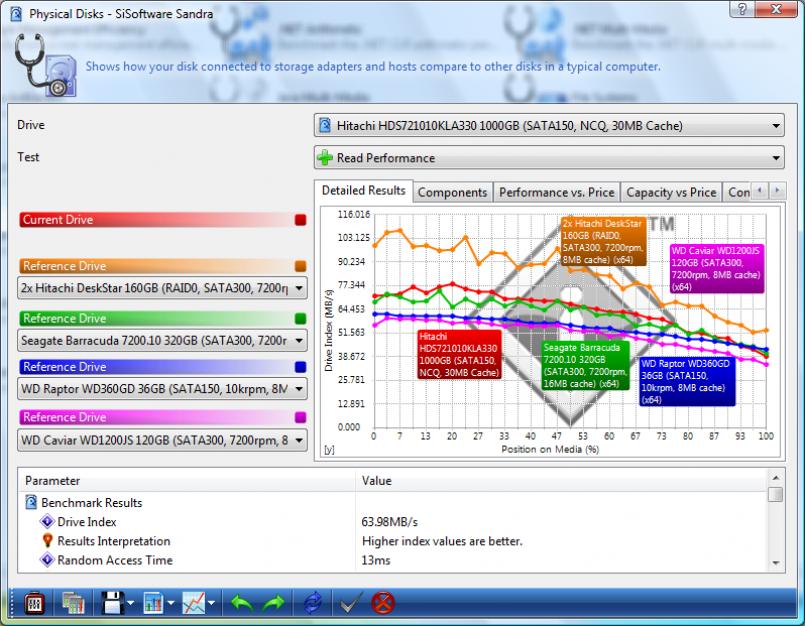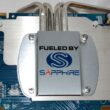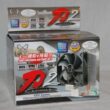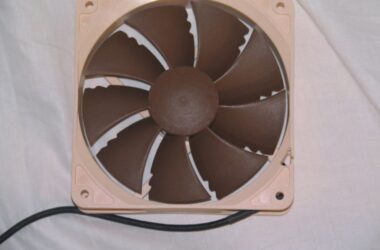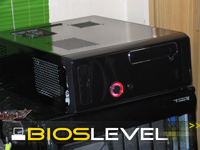Introduction
A few years ago, the idea of a terabyte hard drive seems almost ludicrous. However, with the increase in digital music and movie sales, and the ever-increasing size of video games, the idea of a one terabyte hard drive finally seems realistic.
Hitachi was the first company to release a one terabyte hard drive, and they’ve sent us the DeskStar 7K1000 model for review. The DeskStar 7K1000 features SATA II compatibility, 8.5ms seek time, and 7200RPM rotational speed.
Packaging & Appearance
We received the retail version of the 7K1000, which ships in an all-white carboard box. Wrapped around the box is a red ribbon, which prominently displays how much “stuff” you can fit on to the drive.
The rear of the box and ribbon list more features of the 7K1000, as well as the easy installation into a PC.
The red ribbon has to be removed before opening the box. After that, it’s easy to open the top of the box. The user’s manual is in the top of the box. The drive itself is under the first layer of foam, packaged safely away from harm.
The drive itself features a SATA data connection, SATA power connection, and a good old molex power connection.
Specifications
| Model | Hitachi Deskstar 7K1000 |
| Part Number | 0A35155 |
| Capacity | 1 TB |
| Sector size | 512 bytes |
| Disks/heads | 5/10 |
| Interface | Serial ATA 3.0 Gb/s |
| Buffer Size | 32 MB |
| Rotational Speed | 7200 RPM |
| Media transfer rate (max) | 1070 Mb/s |
| Interface transfer rate (max) | 300 MB/s |
| Latency | 4.17 ms (average, 7200 RPM) |
| Seek time | 8.5 ms read (typical), 9.2 ms write (typical) |
| Silent-seek time | 14 ms read (typical), 15 ms write (typical) |
| Error rate (non-recoverable) | 1 per 1.0 E15 bits transferred |
| Load/unload cycles (at 40?) | 50,000 |
| Power Supply | +5 VDC (+/- 5%), +12 VDC (+10% / -8%) |
| Start up current (max) | 2.0 A (+12V), 1.2 A (+5V) |
| Acoustics (A-weighted sound power) | Idle: 2.9 bels (typical) |
| Acoustics (A-weighted sound power) | Silent seek, Seek: 3.0 bels (typical), 3.2 bels (typical) |
| RoHS compliant | yes |
| Warranty | 3 Years |
With a whopping 5 platters and 10 read/write heads, the drive is definitely heavy. It may not compare to an ancient 5.25″ hard drive, but I can feel the heft of this drive at 700g.
Features
With the massive set of technical specifications found for this drive, I expected a decent set of features. This is exactly what I found looking through Hitachi’s website.
- Storage capacities up to 1TB
- Perpendicular magnetic recording technology
- SATA 3.0Gb/s interface
- Ramp load design increases shock protection and power savings
- Thermal monitoring and fly height control enhance reliability
- Three low-power idle modes boost power efficiency
- Silent seek acoustics achieve ultra-quiet operation
- Host/drive authentication for hardware security
Test Setup
I’ll be using our Core2 Quad machine for this test, because we still haven’t found a solution to the hard drive speeds in Linux on the Sapphire 780G motherboard.
| Processor | Intel Core2 Quad Q6600 |
| Motherboard | ASRock 4Core1333-Viiv |
| RAM | 4GB Crucial Ballistix Tracer DDR2-800 |
| Video Card | BFG GeForce 8800GTX |
| Power Supply | StarTech.com WattSmart 750W |
| Hard Drive | 2x 36GB Raptor |
| Operating System | Windows Vista Business / Gentoo Linux |
Windows Usage & Performance
The drive was detected in Windows without a problem. Windows show the total space as 931.51GB. That’s more space that I have in my server, and this is only a single drive! To benchmark the drive, I’m going to use the Sandra suite to benchmark the drive, as well as real-time copying.
As I’d expect from any newer drive, the 7K1000 is very quiet. I don’t hear much of anytime coming from the case aside from the hum of fans.
Sandra Suite
SiSoft provides two excellent hard disk benchmarks with the Sandra suite: Physical Disks, and Filesystems. I’m going to use the physical disk benchmark, which will benchmark read speed, write speed, and latency/access times.
Sandra reports the average drive read speed as being 64MB/sec, with a 13ms random access time. This isn’t bad at all, considering the drive moves data faster than the 36GB Western Digital Raptor. Aside from the larger 32MB cache, the hard drive platters are also more densely populated, making for faster read speeds.
I’ve decided to omit the results for the Sandra’s write benchmark, as it was reading over 100MB/sec in speed. After turning off the drive’s “advanc
ed performance” in Control Panel, write performance dropped to a meager 6.9MB/sec. Both of these results are inconsistent with both the drive and other drives I’ve seen. I’m hoping that actual copy benchmarks will yield better results.
Copy Tests
To get a realistic idea of what kind of performance to expect from the drive without relying on synthetic benchmarks such as Sandra, I’m going to use a 750MB movie file to copy back and forth between the Hitachi 7K1000 and two 36GB Raptors in RAID0.
| Transfer | Time | Speed |
| Write (RAID0 -> 7K1000) | 21s | 35.71MB/sec |
| Read (7K1000 -> RAID0) | 12s | 62.5MB/sec |
For the drive’s write speed, I finally see something much more acceptable when compared to the results from the Sandra suite. I don’t have an explanation for Sandra’s readings, but the results from this copy test were much more satisfying.
The results from the read test are very similar to Sandra’s results, but slightly slower. This may have been a bottleneck imposed between the three drives (7K1000 and two Raptors).
Linux Usage & Performance
For our tests in Linux, the drive was formatted with ReiserFS. The ASRock 4core133-Viiv’s Intel P965 chipset is well-supported in Linux, unlike AMD’s 780G. This means I’ll be able to properly benchmark the hard drives at full speed.
hdparm
hdparm stands for Hard Drive Parameters, and adjusts just that. Specifically, hdparm has a wide set of tools for ATA drives, such as adjusting the DMA. For other drives, the options become much more limited, as they rely more on hardware settings than software. Using the ‘-t’ flag, hdparm returns the buffered disk reads, or essentially the average read speed.
# hdparm -t /dev/sdb/dev/sdb: Timing buffered disk reads: 216MB in 3.05 seconds = 70.82 MB/sec
I repeated the above benchmark several times over, each time with the speeds varying from 68MB/sec to 72MB/sec. I was a little surprised the drive performed better in Linux, but it works for me.
dd Tests
dd takes an input, output, and various sizes and writes to disk. In our case, we always use /dev/zero, since /dev/zero continuously outputs 0 and a fixed rate (much faster than a hard drive can read / write). I’ll be copying a little over 4GB to drive to test write performance.
dd if=/dev/zero of=/mnt/7K1000/test bs=1024 count=40000004.1 GB copied, 110.194 seconds, 38.1 MB/s
Linux’ write performance has also slightly outshone Windows. Let’s see how the drive holds up in copy tests.
Linux Copy Tests
Much like in Windows, I’ll also be testing file copying in Linux. Using the same 750MB movie file, I’ll copy the file between the 7K1000 and two Western Digital Raptors in RAID0.
| Transfer | Time | Speed |
| Write (RAID0 -> 7K1000) | 19.82s | 37.74MB/sec |
| Read (7K1000 -> RAID0) | 10.74s | 69.83MB/sec |
The results from this test are very similar to both the transfer tests in Windows, as well as the results we saw from the previous Linux benchmarks. Again, performance seems to be higher in Linux.
Final Thoughts & Conclusion
The Hitachi 7K1000 drive has proven it’s speed to me. Through a series of benchmarks in both Linux and Windows, this drive has proved it’s dominance over other offerings. When compared against other drives through the Sandra Suite, it comes out on top against other SATA II drives. RAID0 still beats the 7K1000’s single drive performance, however.
Performance in Linux actually appeared to be a little higher than in Windows, and I’d like to attribute this fact to the 64-bit version of Windows Vista, but I can’t be sure without further testing. Sufficient to say, we should see equal hard drive performance in both Linux and Windows.
Despite the performance differences, the margin between the numbers isn’t too large. The Hitachi 7K1000 is a solid performer in Linux or Windows, and would make a terrific addition to any system. Of course, with that much storage, users will want to make sure they back up that data. In that case, order two and put them in RAID0!
Pros
- Fast at 7,200RPM
- Relatively Quiet
- Plenty of storage!
- Cheap at $.22 per gigabyte
Cons
- Lots of space with no backup! (I’ll take 2!)
- Heavy



